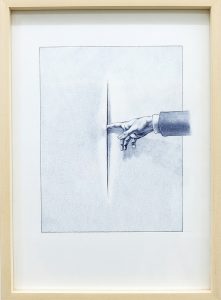Group Exhibition. Fabrizio Cotognini, Zehra Doğan, Regina José Galindo, Iva Lulashi, Ruben Montini & Giuseppe Stampone
The Milanese gallery PROMETEO GALLERY returns to Madrid with GALERÍA NUEVA with a series of artists who propose new views on issues such as feminism or homophobia. Occupying both GALERÍA NUEVA’s own space and that of CRUCE, PROMETEO GALLERY brings us closer to the work of Fabrizio Cotognini, Zehra Doğan, Regina José Galindo, Iva Lulashi, Ruben Montini and Giuseppe Stampone. In this way the gallery presents for the first time in Spain some of its youngest artists, while offering in the city the possibility of knowing the most current work of its most recognized artists.
In the space of GALERÍA NUEVA the work of Fabrizio Cotognini, Iva Lulashi, Ruben Montini and Giuseppe Stampone dialogues on its two floors through references to the history of art and personal conflicts with which we can identify. In CRUCE we find a dual exhibition in which Regina José Galindo and Zehra Doğan develop works that bring us closer to the reality of violence against women in Guatemala and Armenia.
Fabrizio Cotognini
Cotognini was born in Macerata (Italy) in 1983 and lives and works in Civitanova Marche (Macerata, Italy). His work is characterized by a constant reference to Antiquity revisited in a contemporary key. Drawing is for him a key element in his research, as well as new technologies. Cotognini’s work is interested in the various declinations of the archaeological and historical-artistic horizon. Time, memory and history are, in his research, majestic figures, at the same time twisted, overturned or curved in a scenography destined to instability. It is a discourse where the word merges with the image in a close dialogue between sign, design and writing that becomes a place of contemplation and, at the same time, of reflective concentration.
In Fabrizio Cotognini’s words: “my artistic research is based on a process of contamination conceived as a matter of interactions, intrusions and fusions between images and verbal signs. (…) The aim of my work is to detect the link between writing and anti-writing”.
Iva Lulashi
The most recent work of Iva Lulashi (Tirana, 1988) proposes a reflection on a new and contemporary counter-representation of desire and an account of power and history from a female point of view. The work she starts from is the research she presented in her 2018 solo show Eroticommunism at Prometeo Gallery (Milan) on the communist imaginary and the relationships between political propaganda and eroticism. In the work we can now see in Madrid she investigates the representation of desire as a device of liberation and subversive charge of an erotic capital yet to be explored.
Her painting does not reject the exposure of the female body and its nudity, nor does it omit the original provenance of the chosen subjects, but rather reverts them through a personal way of looking at the body, pleasure and its representation. It is an intelligent and provocative shot at the male gaze, with the same means that power and the historical narrative have always used. In the suspended atmospheres of his erotically charged works we find a new position of the feminine as a desiring being.
Ruben Montini
Montini’s (Oristano – Italy, 1986) research has been directed in the last fifteen years to attack heteronormative stereotypes linked to sex, sexual orientation and gender identities. She has confronted, through the performative, uncomfortable but current and critical issues. These characteristics have determined the results of an aesthetic strategy that has marked the search for this complex artist in the world of Italian performance. Through the exhibition of his own naked body, tattooed, humiliated and sometimes wounded and bleeding but glorified, Montini has represented his Passion, his secular martyrdom, a Way of the Cross composed of actions that reveal the topography of an imperfect body, a desacralized Ecce Homo. Montini has engraved on his body the traumas, pain and suffering that the Social Body inflicts on people considered “different”.
Embroidery is fundamental in Montini’s multifaceted artistic vocabulary. She recontextualizes an activity usually linked to women’s duties and often relegated to the “minor arts”, turning it into a tool capable of celebrating, ironically and polemically, the subversion of socially accepted norms, as is often the case in the artist’s work.
Giuseppe Stampone
Stampone’s (Cluses, France, 1974) artistic quest is a synthesis and formalization of the concept of “Global Education”. His artistic production ranges from interactive multimedia installations to monumental and participatory public art projects. Simultaneously, his work refers to the “reasons for doing” by insisting on the aesthetic gratification obtained by drawing with a BIC pen. His work methodology is based on a chain of relationships, collaborations, connections and participations developed through the Solstizio network that he founded in 2008 with Maria Crispal.
In this cybernetic era in which we live, knowledge becomes connective because everyone can interact, exchanging their own experiences with others on shared topics and areas of interest. “Global Education” is a project born in light of these changes. It begins with alphabetical primers drawn in BIC pen (school material par excellence), playing with popular themes, labels, symbols and images, often pertaining to historical facts or current events. These are followed by concept maps, slogans, interactive installations and tours of various countries around the world, such as the ones the artist organized for the Kochi and Havana Biennials (2012).
Zehra Doğan
In her early thirties Zehra Doğan (Diyarbakır, Kurdistan, 1989), an artist, journalist and activist of Kurdish origin, has become a spokesperson for her people, as well as for the Armenian people, whose women – including her grandmother – were sold into slavery, forcibly converted to Islam, victims of unimaginable violence during the genocide that has taken place between 1915-1916.
Only recently has the deportation and murder of 1.5 million people by the Ottoman Empire been recognized in the fabric of the great story. Small great stories such as those of Fatma, Hawê, Xanê, women deprived even of their names, have nevertheless left their traces, their testimony, an example of courage and valor. In 2019, on the occasion of the centenary of the massacre, Pope Francis and Barack Obama – together with the US Congress – have officially taken a position recognizing it as “the first genocide of the 20th century”. A swampy denialism endorsed by President Recep Tayyip Erdoğan persists in today’s Turkey. For this reason the cry of the women evoked by the artist is all the more deafening, who before reducing themselves to silence, before allowing themselves to be overwhelmed by the dogmas imposed to eradicate their roots – or even to take their own lives – reveal their own traumas. Traumas that Doğan has transformed into works, into dolls that hang from the ceiling and around which unpublished canvases and videos complete the fresco of these stories that through art acquire an eternal character.
Regina José Galindo
The souls of other women, along with their tragic stories, find a voice in the work of artist and poet Regina José Galindo (Guatemala, 1974) through various performances conceived during her confinement. Detrás de la ventana (2020), Aparición (2020) and Monumento a las desaparecidas (2020) are some of the pieces created by the artist, winner of the prestigious “Robert Rauschenberg” award in 2021. Some of these works, a record of the performance planned by the artist, have been directed from a distance due to the impossibility of traveling because of the restrictions imposed by the sanitary emergency. Monumento a las desaparecidas is a living and temporary monument to the women victims of femicide, souls remembered through the physical presence of the performers covered by cloaks that resemble evanescent spirits. Graceful, deafening, powerful as a scream, they claim: “our greatest revenge – wrote Galindo – is to stay alive”. Playing, singing, shouting is an act of vindication and denunciation.
Galería Nueva, C/ Doctor Fourquet 10
CRUCE, C/ Doctor Fourquet 5
28012 Madrid






